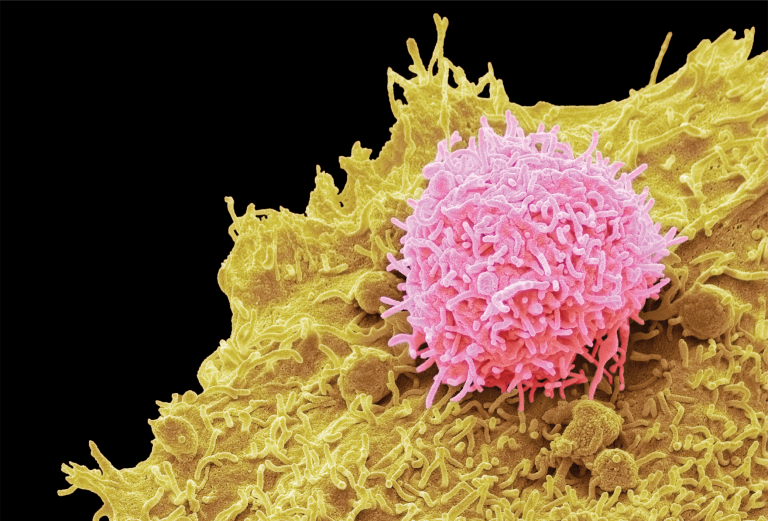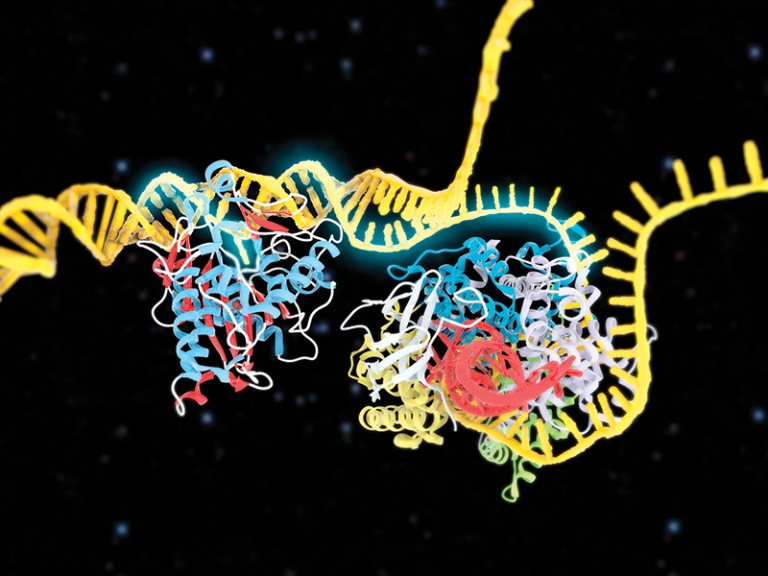Alumni Reflect on Game-Changing Medical Discoveries
Which scientific or medical development has excited you the most during your career?
- Alumni Rounds

This colorized scanning electron micrograph shows a T-cell (pink) that has been modified to target cancer cells, in this case, a prostate cancer cell. This therapeutic approach, called CAR T therapy, is being used to treat certain blood cancers, including lymphomas.
Jorge Casas-Ganem, MD ’98
As a sarcoma surgeon, the improvement in diagnosis and the development of targeted therapies have improved outcomes and survival for my patients. On the reconstructive side, 3D printing techniques for patient-specific custom implants have been a game changer. We are now reconstructing bony defects that previously could not be reconstructed.
John Welch, MD ’68
Beginning in the early 1990s with laparoscopic cholecystectomy, the explosive development of laparoscopic surgery made possible by advances in instrumentation revolutionized the field of general surgery. New leaders in the field rapidly gained prominence in academic surgical societies, and the public and insurance companies embraced small-incision operations and early hospital discharges.
Benjamin Chaska, MD ’83
The identification of the cause of AIDS together with the treatments developed. The use of mRNA technology to develop vaccines for SARS-CoV-2 and the further exploration of that technology to develop vaccines against other infectious agents. The monoclonal antibody revolution. The vast numbers of new and efficacious treatments for heart disease and cancer.
Stephen Smith, MD ’63
As an endocrinologist, I have been excited and gratified regarding the opportunity to implement GLP-1 agonist therapy for treatment of certain patients with type 2 diabetes. For many patients this class of medication is superior to insulin and other pharmaceutical options.
Jane Liebschutz, MD ’91
Changes in treatment for addiction have been life-changing for so many individuals with opioid use disorder, in particular, office-based treatment with buprenorphine. This has expanded the capabilities for treatment outside of stigmatized and hard-to-access methadone programs.
Charles Epstein, MD ’73
I consider CRISPR-Cas9 to be one of the more exciting scientific developments.

Esteban Mezey, MD ’62
The completion of the human genome sequence. It is revolutionary for the diagnosis, prevention, and treatment of disease.
Petros Giannikopoulos, MD ’06
It’s hard to narrow this down to just one, so I will go with three: large-scale genomics, including whole-genome sequencing, RNA sequencing, single-cell sequencing, and spatial multiomics; CRISPR-based genomic editing; and artificial intelligence.
Kenneth Franklin, MD ’78
Invasive cardiology, such as coronary artery angioplasty, has been an important innovation.
Linda Leum, MD ’86
Too many to list. My dear friend and HMS classmate, Jeannie Bennett, MD ’86, developed the first FDA-approved gene therapy for a type of childhood blindness.
Peter Liebert, MD ’61
The development of total parenteral nutrition.
Elizabeth Kaufman, MD ’85
If anyone had told me how far pacemaker and defibrillator technology would advance during my career, I would have thought they were writing science fiction. Keeping up with the new developments, both intellectually and from a skill set standpoint, is exciting. It is always fun to be on a learning curve.
Robert Duerr, MD ’88
I believe the two greatest achievements in my lifetime were the invention of statins, which will soon mean that cardiovascular disease will no longer be the number one cause of death in the United States, and checkpoint inhibitors.
Samuel Gerber, MD ’80
Conversion from open to arthroscopic procedures of the shoulder, ankle, elbow, hip, and knee.
Lise Johnson, MD ’88
The rapid advances of genomic medicine.
Morris Fisher, MD ’65
The development of molecular biology and increased clinical neurophysiological capabilities based on the ready availability of computers.
Gordon Cutler, MD ’73
In fifty years, advances in molecular biology and genetics have enabled whole new classes of therapeutics, including recombinant human proteins, monoclonal antibodies, and DNA- and RNA-based treatments, which have achieved great progress in endocrinology, inflammatory diseases, oncology, cardiovascular disease, and vaccine development and hold great promise for neurology, genetic diseases, and other fields.
Martin Prince, MD ’85
The development of magnetic resonance imaging.
Daniel Weingrad, MD ’73
Probably the validation of breast conservation and multidisciplinary therapy for the treatment of breast cancer. This change in treatment has had enormous impact on the well-being of many women.
Mary Flowers, MD ’78
The notion of transplanting pig kidneys into humans to reduce the number of end-stage renal disease patients waiting for kidney transplants.
Frank Seinsheimer, MD ’71
The advances in immunology and genetic therapy.
Bruce Parker MD ’63
Magnetic resonance imaging is an important advance.
Daniel Kopans, MD ’73
The early detection of breast cancer has been a major advance. Screening began in the mid-1980s and the death rate, unchanged over the prior fifty years, has declined by more than 40 percent since 1990. Therapy has improved, but breast cancer is cured when treated early. I developed a guidewire that directs surgeons to lesions in the breast that appear on imaging but that cannot be felt. I believe this innovation has allowed for safe, less traumatic outpatient biopsies that can help physicians make those early diagnoses of breast cancer that improve outcomes for patients.
Gregory Juarez, MD ’92
The use of ultrasound in the perioperative arena. We can provide safer and advanced blocks in the OR to improve outcomes in our patients. Also, real-time ultrasound has given us access to viewing the cardio- pulmonary system to diagnose and treat acute issues.
Scott Wasserman, MD ’96
It is hard to believe that about twenty years have passed since the sequencing of the human genome. This development, augmented by computing power, revolutionized health care and made the current biotech innovations possible. Stemming from this development, scientists and physicians can personalize treatments for cancer, identify the causes of and develop treatments for rare diseases, and develop cell and gene therapies.
Sylvester Sviokla, MD ’72
All forms of imaging in the first half of my career and the development of buprenorphine and naloxone combination drugs in the second half.
Martin-Jose Sepulveda, MD ’78
The recognition and disclosures of bias, discrimination, and structural racism in medicine and medical practice.
The development of new imaging techniques, plus microsurgery.
Howard Kirshner, MD ’72
The development of acute stroke treatment, first in 1995 with intravenous tPA, later with mechanical thrombectomy. Many strokes are now treatable, and many more patients who would have been disabled for life are recovering well.
Nneka Holder, MD ’97
Vaccines, especially those developed against human papillomavirus and SARS-CoV-2.
Karen Singer, MD ’77
During a medical school research elective, my student, Russell A. Brown, developed the CT-guided stereotactic frame, which uses N-localizer technology. This development has had a major influence on modern neurosurgery and stereotactic radiotherapy — perhaps not as significant as modern genetics, but still a great contribution to improved patient care. Another exciting development, and there have been many, was endoscopic surgeries for appendectomies, hysterectomies, knee meniscus surgeries, and so many more procedures. The development of robotic surgery has advanced things even further.
Fred St. Goar, MD ’84
I have had the pleasure and privilege of helping to develop some exciting cardiovascular therapeutic advances such as the MitraClip and HeartFlow imaging. But the innovation that I am most excited about, and proud of being involved with, is the JADA postpartum hemorrhage control device, which will make childbirth safer for mothers around the world.
Stephen Grund, MD ’91
As a hematologist/oncologist, it’s impossible to choose just one. Unraveling the pathophysiology of thrombotic thrombocytopenic purpura, paroxysmal nocturnal hemoglobinuria, and heparin-induced thrombocytopenia and thrombosis have been important advances. I would also choose the use of all-trans retinoic acid and arsenic for acute promyelocytic leukemia and imatinib for chronic myelogenous leukemia. CAR T therapy and checkpoint inhibitors have also been exciting developments.
Edmund Lee, MD ’96
The advent of biologic medications for skin diseases such as psoriasis.
Susan Haas, MD ’79
I consider the development of minimally invasive surgery and medication abortion to be important advances made during my career.
The applications and evolution within plastic surgery blossomed during the early years of my professional life.
Brian Lewis, MD ’69
The insights into the biology and treatment of cancer that have revolutionized oncology.
Richard Schwartzstein, MD ’79
Advances in managing critically ill patients.
Donald Brief, MD ’57
The CAT scan and minimally invasive surgery are advances I consider to be important.
James MacDonald, MD ’95
The change in the treatment of many cancers from chemotherapy and radiation to immune-modulated therapies, for example, the use of Rituxan in lymphoma. Also, the growing awareness of the roots of systemic racism that is central to U.S. medicine.
Robin Yuan, MD ’78
While the technique of microsurgery was invented much before my career began, the applications and evolution within plastic surgery blossomed during the early years of my professional life and opened a door to reconstructive possibilities that were challenging, stressful, and exciting.
Steven Jonas, MD ’62
The recognition of the importance of public health practice, even as politics in our nation — the only country in the developed world that does not have a national health insurance system — have diminished its scope, funding, and influence.
Joseph Burnett, MD ’58
The development of retinoids.
George Lewinnek, MD ’67
Acute stroke treatment, first with intravenous tPA, then with mechanical thrombectomy. Also the advances in imaging, including CT scans and MRI. Although these advances were exciting, I was sorry that young doctors never learned the clinical skills we once needed. There were times when the imaging missed the pathology, and because I was old enough to have learned physical diagnosis, I knew enough to keep looking.
Craig Comiter, MD ’92
The use of immunotherapy for cancer treatment has been exciting.
James Reiss, MD ’62
The development of new imaging techniques, plus microsurgery.
Mitchell Rabkin, MD ’55
The insight on DNA and the exquisite technologies of biomedical investigation.
Marguerite Barnett, MD ’79
The development of genomic medicine.
Michael Quinones, MD ’86
Tyrosine kinase inhibitors, by far. Small molecules treating and potentially curing cancer is a big leap from the original chemotherapy Sidney Farber, Class of 1927, used!
Christopher Baker, MD ’74
The research that has characterized systemic inflammatory response syndrome and helped clinicians prevent and treat multiple organ failure in critically injured or ill patients.
William Goodson, MD ’71
The transition from opinion- and authority-based decision-making to the wide application of prospective clinical trials, preferably randomized, to guide medical decisions.
Jan Polissar, MD ’61
Transactional analysis and the discovery of the structure of the human genome.
Robert Colvin, MD ’68
The discovery of the CRISPR tool has been exciting.
Images: Steve GSchmeissner/Science Source (CAR T); Ramon Andrade 3Dciencia/Science Source (CRISPR)